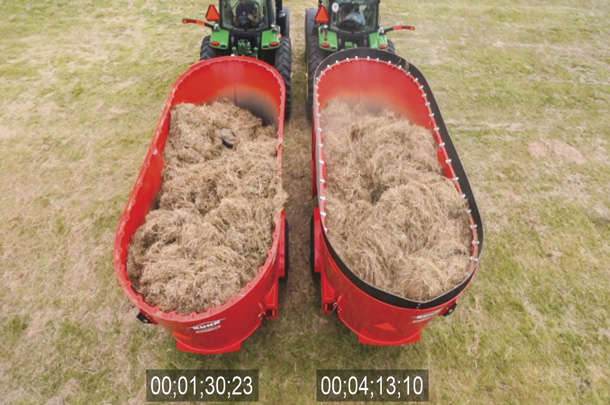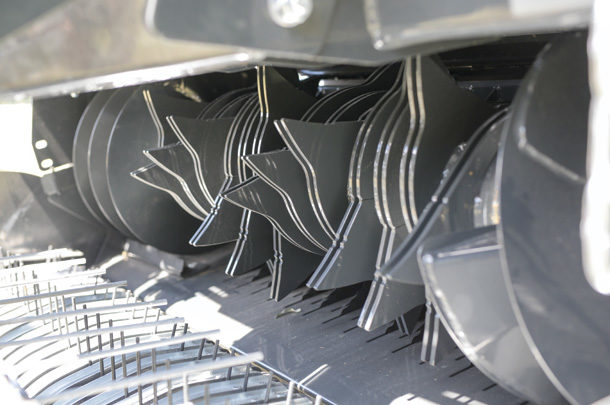Spring is here, and it is time to start thinking about equipment and crops. When it comes to alfalfa fields, what is the plan for harvest for each cutting?
Will it all be chopped for silage, or will you be making bales? If the decision is for bales, have you considered the many advantages of making cut bales?
The benefits of pre-cut bales fall into four categories:
- Transportation and packaging savings
- Improved silage feed value
- Increased feeding efficiency
- Time savings while processing bales
When discussing transportation and bale packaging, your cost and savings are directly connected to the density of the bale. The denser a bale is, the less net wrap (less plastic film when wrapping), and less fuel is required to transport the same amount of feed. Packing more tonnage into each bale allows you to reduce the overall number of bales you handle, saving you time and money. Cutter balers enable you to make higher-density bales by sizing the crop down into smaller pieces, making the crop fit more tightly together.
Transportation savings are seen across the bale supply chain when creating a denser bale. You will produce fewer bales overall, resulting in having to move fewer bales off the field and fewer bales to move to the final feeding place. If you sell alfalfa and hay, you can see large transportation savings when getting that feed to the point of sale. When we look at twine, net wrap and plastic film wrap, these items are primary inputs for any farm producing bales. Decreasing net, twine and film by 10% adds up to large cost savings over the life of a baler.
In addition to transportation and packaging savings, improved bale density from a cutter baler results in higher feed value for ensiled bales. Processing crop down to as little as 1.8 inches in length creates a bale with less air per cubic foot. All operators who wrap hay or silage know oxygen is the enemy of a good silage bale. When forage is ensiled, oxygen is stored between forage particles. Pre-cutting bales with a cutter allows the smaller-sized particles to fit together tightly, trapping less air. By removing the air, you also preserve the forage quality through the fermentation process.
Think of it like this: When you have a glass filled with large ice cubes, there is a lot of empty space to add your beverage – but if you have a glass with crushed ice, there is very little room to add your beverage. Lowering the oxygen content in wrapped bales helps ensure a high-density silage bale with less spoilage, resulting in a better fermentation process, increasing the feed’s value and return on investment. If your bales reach a temperature of over 120ºF, your crude protein (CP) level starts to decrease, as well as other nutrients and feed value.
A baler with a cutting rotor also provides benefits when baling dry hay, reducing feed waste and improving feed intake when the bale is fed. When an animal reaches into the feeder or bunk and pulls out a mouthful of long-stemmed hay, only 4 or 5 inches of the long pieces of hay are actually within the animal’s mouth. The remaining portion that hangs out of the animal’s jaw will more than likely fall to the ground and be wasted when the animal starts to chew. This can often be seen by the large buildup of feed on the outside of a bale ring feeder.
 To show the difference in mixing time when processing cut versus uncut bales, Kuhn performed a side-by-side demonstration with two 5-by-6-foot bales, both processed in identical VT 156 GII vertical mixers. Photo provided by Kuhn North America.
To show the difference in mixing time when processing cut versus uncut bales, Kuhn performed a side-by-side demonstration with two 5-by-6-foot bales, both processed in identical VT 156 GII vertical mixers. Photo provided by Kuhn North America.
Feeding forage of shorter lengths keeps more of the hay inside the cow’s mouth and off the ground. It also allows livestock to consume feed at a higher rate, resulting in faster weight gain. Hay pre-cut to shorter lengths requires less chewing and less time for cattle to ingest a mouthful and move on to the next. Independent research studies have shown feeding pre-sized hay directly results in higher rates of gain for cattle (Penn State).
If you are using a mixer to combine a ration and process hay, cut bales break apart much more easily, reducing the time and horsepower required to mix the ration. To show the difference in mixing time when processing cut versus uncut bales, we performed a side-by-side demonstration with two 5-by-6-foot bales, both processed in identical VT 156 GII vertical mixers. The two bales used were both made with a Kuhn VB 560 round baler; however, one bale was made with a rotor-cutting model and the other did not have a cutter.
The mixer with the cut bale was able to tear the bale apart in a smooth manner, fully separating the bale in only a minute and a half. The mixer that processed the bale of full-length crop took much longer to break apart the bale. The bale core shifted in the mixer, creating high- and low-horsepower loads on the tractor. It took four-and-a-half minutes of mixing to break this bale apart, three times longer than the cut bale. The mixer continued to mix the uncut hay after it was fully broken apart in order to reduce the particle size to similar lengths as the pre-cut bale. Producing a similar particle length took an average 12 minutes of total mixing time for the uncut bale, 10 minutes and 30 seconds of additional mixing time for the same final product.
For an operation mixing 500 bales per year, this adds up to nearly 90 additional hours of mixing each year. Lower operating time on your mixer greatly affects your farm’s bottom dollar when accounting for all the costs. Each hour the mixer is running costs fuel, labor, tractor depreciation and mixer depreciation. Based on the average mixing times and differences in horsepower requirements from the demonstration, it is roughly eight times more expensive to break apart and size an uncut bale compared to a cut bale when using a mixer. This is a huge potential savings for your operation.
Whether you are selling bales, buying bales or baling your own feed, operations of every size and structure can benefit from producing and feeding pre-cut bales.






